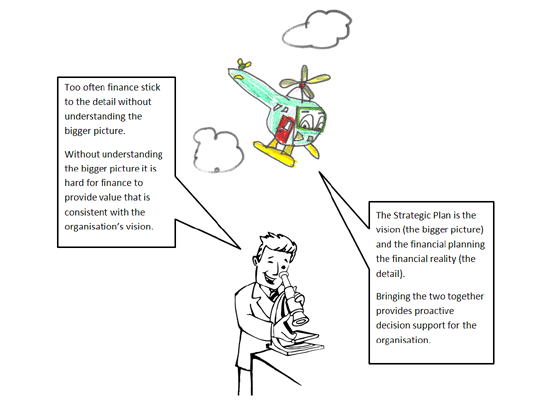
By Stuart Bilbrough*

This is the fourth of six articles that look at how to transform a company’s Finance function into an effective business partner and provider of value.
This transformation focuses on training.
They drill down on an article called “Closing the Skills Gap” that was published on interest.co.nz on the 8th October last year.
The first three articles discussed the foundation skills required of a Finance team before they can effectively add value and applicable to any Finance team supporting an SME, not for profit, Government or large multi-national organisation.
All organisations should have an expectation that their Finance teams add value and contribute to the business they support.
This expectation should not rest with just the CFO and their management accountants.
It should include the likes of accounts receivable, accounts payable, payroll and core accounting, all of which have historically been considered transactional support and largely invisible to the organisation.
The first article stressed the importance of a strong control environment and continuous validation of data to ensure it is correct before handing it over to the key decision makers in an organisation. Nothing spoils the credibility of financial information more than material errors.
The second article provided guidance on how to identify and interact with the key decision makers in the organisation through effective stakeholder management.
The third provided the tools and guidance to present meaningful financial and non-financial analysis. Rightly or wrongly analysis is often judged by the professionalism of its appearance rather than the information it aims to provide.
The Value – Financial Planning and the Strategic Plan
This article introduces an understanding of financial planning and the Strategic plan.
It demonstrates the need to tie the strategies of an organisation to its financial realities using financial planning tools.
Importantly, this article demonstrates that it is financial planning where Finance can add the most tangible value.
Adding value using historical data tends to provide reactive solutions. Adding value during a financial planning process provides proactive opportunities that become tangible and positive outcomes for the future.

The Objective
The competencies of strategic planning and financial planning are individually significant subjects in their own rights. The objective of this article is not a mini MBA on the subjects rather providing an introduction to each and then demonstrating where value can be added. Some generic examples are provided later in this article.
It is through financial planning where Finance can add proactive, tangible and insightful value to the business it supports and those who influence it.
Is your Finance team hearing the following?
“Accounts own the inputs and the outputs of the budget. Go ask them.”
“I spend more time budgeting the business than working on growing the business.”
“How is the Accounts team strategically relevant in an ever increasing cost containment environment? Better off outsourcing the whole team. I see no value.”
Would you prefer to be hearing?
“Finance engages, understands the strategies and interprets the business, then provides credible forecasts with every users buy-in.”
“Finance is an integral part of our Business Development Team.”
“The forecast process coordinated by Finance provides not only information to guide the performance of the business and highlight risks but also supplies proactive insights into other areas to maximise the value of my department.”
Strategic planning and financial planning
 Strategic planning seeks to define the direction in which an organisation is wanting to head and the decisions required to get it there. Through a desired future state (the vision) and a quantification of that desired state (the objectives), resources such as people and capital, processes and the organisation’s competencies within its area of operation all come together in the Strategic Plan.
Strategic planning seeks to define the direction in which an organisation is wanting to head and the decisions required to get it there. Through a desired future state (the vision) and a quantification of that desired state (the objectives), resources such as people and capital, processes and the organisation’s competencies within its area of operation all come together in the Strategic Plan.
Financial Planning means different things to different people in different circumstances. It can be related to both personal and business, but for our needs it is the catch-all phrase for the art of planning a financial outcome for a company for the future.
Performing financial planning is critical to the success of any organisation. It provides the Strategic Plan with rigor, by confirming that the objectives set are achievable from a financial point of view. It also helps the CEO/Managing Director and the Board of Directors to set financial targets for the organisation.
The most common form of financial planning is the company budget/forecasts. Financial planning also includes capital evaluations, cost management exercises, product development and funding plans.
Adding value through the financial planning process
The following are some general examples adding value. This list is not exhaustive. Different opportunities work better in different organisations.
I recently talked to the Martin Chisolm, CFO for AA Insurance about this type of added value. When mentioning the importance of internal benchmarking he said that this was less relevant for them due to different types of businesses making up the organisation.
At Radius Care where I am the CFO it is one our strongest means of identifying was to increase revenue and identify cost management opportunities.
1. Efficient Financial Planning Process
Whether it is the annual budget, quarterly reforecast or ad-hoc capital evaluation projects, it is critical that the process in place is efficient and inclusive. In many organisations the financial planning process dominates through inefficiency and the lack of recognition of materiality. It is important that Finance spends more time working with a business then budgeting it.
2. Finance Help Decision Makers Understand the Numbers
It is critically important to ensure that the key decision makers in an organisation understand the outcomes from a financial plan. Not all business unit owners are strong financially. At Radius Care most Facility Managers come from registered nurse backgrounds. Finance should assist where possible in ensuring that financial management is understood. This includes support functions like HR and marketing.
3. Identifying Opportunities to Improve Product and Service Revenue
This includes identifying new revenue making opportunities and stopping those that are unprofitable. External and internal benchmarking is a quick and effective way of identifying these opportunities. At Radius Care strong performing aged care facilities are benchmarked with poorer performers to assist in improving profitability.
4. Identifying Cost Management Opportunities
This is identifying suboptimal spending and stopping it. This is not cost cutting. Like with revenue internal benchmarking is a very effective way of identifying suboptimal spending through comparison with best practice.
5. Leading by Example
Ensuring a Finance function leads by example in containing costs and keeping to budget commitments. Finance’s recommendations to minimise other department costs will lose some credibility if they can’t manage their own!
6. Keeping Tabs on Current Year Objectives
Finances involvement in the strategic planning process assists in ensuring objectives build up to the financial expectations. Finance can keep a tab on objectives and push along opportunities. Through a monthly rolling forecast any delay in the objectives and resulting gap to earnings expectations can be highlighted for immediate resolution.
7. Cash is King, Pre-empt Short and Long Term Funding Needs
Even before an organisation funding requirements are needed or in fact known, it is important to ensure where it can be accessed. Many opportunities requiring financial planning have a funding need therefore Finance knowing where that will come from is critical to seizing opportunities as they arise.
8. Best bang for the buck
Ranking impending capital projects and/or product developments and ensuring those with the best return on investment is prioritised. Keep a list of opportunities that miss the cut. They can be started should a better-than-forecast year eventuate
9. Consider the Timing of New Opportunities
Make sure that revenue-generating opportunities are completed as early as possible in the financial year. This ensures that the revenue benefit of the opportunity is recognised in the same year. For example this may be a major refurbishment or repairs and maintenance. Of course this is not applicable to organisations where a service or product development is seasonal or a development is a multi-period exercise.
10. When strategic expectations do not equal financial reality
Recommend ways to close the gaps – this may require the re-engagement of stakeholders used in the financial planning process. Finance may be able to assist in providing cost reduction opportunities, sensitivity analysis or running different scenarios, revenue benchmarking, etc. to assist in the decision process and in closing the profit gap.
Wrap up
The main focus of this article was to demonstrate that it is financial planning where Finance can add proactive, forward looking and insightful value to the business it supports and those who influence it.
Therefore:
1. Understanding strategy and your organisation’s Strategic Plan is critical to being able to effectively add value to an organisation.
2. A financial plan provides the Strategic Plan with rigor, by confirming that the objectives set are achievable from a financial point of view. It links vision to financial reality.
3. Know what to do when strategic expectations do not equal financial reality.
4. Adding value using historical data tends to provide reactive solutions. Adding value during a financial planning process provides proactive opportunities. The value that Finance can provide now will have tangible and positive outcomes for the future. This is the best value.
Next month
The next article looks at Process Improvement – Challenging the Status Quo.
It looks at how to introduce a culture that asks, ‘How can this be done better?’ and provide the frameworks.
Business process improvement is all about reducing or eliminating inefficient or irrelevant activities that prevent Finance from providing added value to the business they support.
--------------------------------------------------------------------------------------------------------
Stuart Bilbrough is the author of the book, Bean Soup – Beyond Bean Counting. You can read a review of the book here. You can buy it here.
We welcome your comments below. If you are not already registered, please register to comment
Remember we welcome robust, respectful and insightful debate. We don't welcome abusive or defamatory comments and will de-register those repeatedly making such comments. Our current comment policy is here.